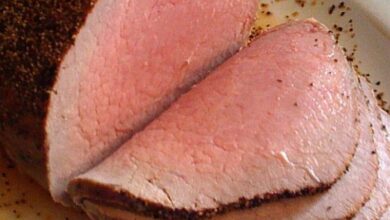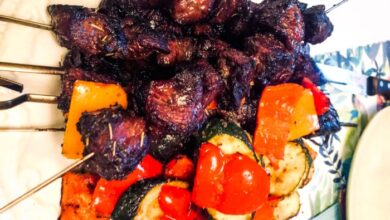
Bulgogi Beef: Korean Style Barbecue
Bulgogi beef Korean style barbecue is more than just a delicious meal; it’s a culinary journey through Korean history and culture. The dish, literally meaning “fire meat,” has been a staple in Korean cuisine for centuries, evolving from humble origins to a global phenomenon.
Imagine thinly sliced beef marinated in a symphony of soy sauce, garlic, ginger, and sesame oil, then grilled to perfection on a hot plate. Each bite is a burst of savory, sweet, and slightly spicy flavors, a testament to the artistry of Korean cooking.
From its humble beginnings to its modern-day global popularity, Bulgogi has captured the hearts and taste buds of people around the world. This article delves into the fascinating history, the essential ingredients, the unique cooking techniques, and the cultural significance of this beloved Korean dish.
History and Origins of Bulgogi
Bulgogi, a beloved Korean dish, is a testament to the rich culinary heritage of the nation. Its origins can be traced back centuries, with its evolution reflecting the changing social and cultural landscape of Korea.
Cultural Significance of Bulgogi
Bulgogi holds a prominent place in Korean culture, transcending its status as a simple dish. It is often served during special occasions, festivals, and family gatherings, symbolizing unity and shared experiences. The act of grilling bulgogi together fosters a sense of camaraderie and connection, solidifying its role as a cultural icon.
Ingredients and Preparation
The magic of Bulgogi lies not only in its grilling but also in its flavorful marinade. This marinade, a blend of soy sauce, sugar, garlic, ginger, and other spices, imbues the meat with a sweet and savory depth, creating a truly unforgettable taste.
Essential Ingredients for Traditional Bulgogi, Bulgogi beef korean style barbecue
The essential ingredients for traditional Bulgogi are simple yet crucial for achieving its signature flavor profile.
- Thinly sliced beef:Bulgogi traditionally uses thinly sliced beef, typically from the brisket or short rib, for optimal tenderness and absorption of the marinade.
- Soy sauce:The foundation of the marinade, soy sauce provides saltiness and umami depth.
- Sugar:Sugar balances the saltiness of the soy sauce and adds sweetness to the marinade.
- Garlic:Garlic adds a pungent aroma and flavor that complements the other ingredients.
- Ginger:Ginger adds a subtle warmth and a touch of spiciness to the marinade.
- Sesame oil:Sesame oil adds a nutty flavor and helps to tenderize the meat.
- Green onions:Green onions add a fresh, slightly sweet flavor and a touch of visual appeal.
- Black pepper:Black pepper adds a touch of spice and complexity to the marinade.
- Rice wine:Rice wine adds a delicate sweetness and helps to tenderize the meat.
The Marinade Process: A Symphony of Flavors
The marinade is the heart and soul of Bulgogi, transforming ordinary beef into a culinary masterpiece. The key to a successful marinade is achieving a balance of flavors, ensuring the meat is tenderized, and allowing the spices to infuse deeply.
- Soy sauce:As mentioned, soy sauce serves as the base, contributing a savory and salty foundation.
- Sugar:The sugar balances the soy sauce’s saltiness and adds a touch of sweetness, creating a harmonious balance.
- Garlic and Ginger:Garlic and ginger contribute a powerful aroma and flavor, adding complexity and depth to the marinade.
- Sesame oil:Sesame oil adds a nutty flavor and helps to tenderize the meat, ensuring a succulent texture.
- Green onions:Green onions bring a fresh, slightly sweet flavor and a touch of visual appeal to the marinade.
- Black pepper:Black pepper adds a touch of spice and complexity, further enhancing the flavor profile.
- Rice wine:Rice wine adds a delicate sweetness and helps to tenderize the meat, creating a tender and flavorful final product.
Different Types of Meat Used for Bulgogi
While beef is the most common choice for Bulgogi, other meats can be used to create delicious variations.
Bulgogi beef is a classic Korean barbecue dish that’s all about tender, marinated beef with a sweet and savory flavor. While I love the smoky char of grilling bulgogi, sometimes I crave a more portable option. That’s where these easy pepperoni pizza muffins come in! They’re a fun twist on pizza that’s perfect for lunch or a quick snack.
But don’t worry, I’ll always have a place in my heart (and stomach) for a good bulgogi feast.
- Beef:The most traditional choice, beef offers a rich and savory flavor that pairs well with the marinade. Brisket and short rib are commonly used for their marbling and tenderness.
- Pork:Pork can be used as a substitute for beef, offering a milder flavor. Pork belly is a popular choice for its marbling and tenderness.
- Chicken:Chicken offers a lighter and more delicate flavor compared to beef and pork. Chicken thighs are a good choice for their juiciness and flavor.
Comparing Cuts of Beef for Bulgogi
Different cuts of beef offer unique characteristics, making them suitable for different grilling styles and preferences. Here’s a comparison of common beef cuts used for Bulgogi:
| Cut | Characteristics | Suitability for Bulgogi |
|---|---|---|
| Brisket | Marbled, flavorful, can be tough if not cooked properly | Excellent for Bulgogi, becomes tender when marinated and grilled |
| Short rib | Marbled, flavorful, tender, can be expensive | Excellent for Bulgogi, melts in your mouth when grilled |
| Flank steak | Lean, flavorful, can be tough if not cooked properly | Good for Bulgogi, becomes tender when marinated and grilled |
| Sirloin | Lean, flavorful, tender, can be expensive | Good for Bulgogi, but may be less flavorful than other cuts |
Cooking Techniques

Bulgogi can be cooked using various methods, each offering unique flavors and textures. The most popular methods include grilling, pan-frying, and stir-frying.
Grilling
Grilling is the traditional method for cooking Bulgogi, and it allows the meat to develop a delicious smoky flavor and crispy exterior.
- Bulgogi is typically grilled over a charcoal grill, but gas grills can also be used.
- The grill should be heated to medium-high heat before cooking.
- The meat should be cooked for about 2-3 minutes per side, or until it is cooked through.
- The meat should be brushed with a marinade during cooking to enhance the flavor and prevent it from drying out.
Pan-Frying
Pan-frying is a convenient method for cooking Bulgogi, and it can be done on a stovetop or in a skillet.
- The skillet should be heated to medium-high heat before adding the meat.
- The meat should be cooked for about 2-3 minutes per side, or until it is cooked through.
- The meat should be flipped frequently to ensure that it cooks evenly.
- The meat should be brushed with a marinade during cooking to enhance the flavor and prevent it from drying out.
Stir-Frying
Stir-frying is a quick and easy method for cooking Bulgogi, and it can be done in a wok or a large skillet.
Bulgogi beef, with its sweet and savory marinade, always reminds me of lively gatherings. The smoky char of the grilled meat is a sensory experience that’s hard to beat. But if I’m craving something lighter and equally flavorful, I turn to a creamy and comforting dish like mussels and pasta with creamy wine sauce.
Both dishes are fantastic in their own right, showcasing the beauty of diverse culinary traditions. And when I’m done indulging in the rich flavors of bulgogi, I know I can always rely on a lighter and equally satisfying meal.
- The wok or skillet should be heated to high heat before adding the meat.
- The meat should be cooked for about 1-2 minutes per side, or until it is cooked through.
- The meat should be stirred frequently to ensure that it cooks evenly.
- The meat should be tossed with a marinade during cooking to enhance the flavor and prevent it from drying out.
Cooking Bulgogi on a Traditional Korean Grill (Bulgogi Gui)
- Prepare the grill by heating it over medium-high heat.
- Marinate the beef for at least 30 minutes, or up to overnight, to allow the flavors to penetrate the meat.
- Place the marinated beef on the grill and cook for 2-3 minutes per side, or until it is cooked through.
- Brush the meat with additional marinade during cooking to enhance the flavor and prevent it from drying out.
- Once the meat is cooked, remove it from the grill and slice it thinly against the grain.
- Serve the Bulgogi immediately with your favorite side dishes, such as rice, kimchi, and lettuce wraps.
Tips for Achieving the Perfect Balance of Flavors and Textures in Bulgogi
- Use high-quality beef, such as ribeye, sirloin, or tenderloin, for the best flavor and texture.
- Marinate the beef for at least 30 minutes, or up to overnight, to allow the flavors to penetrate the meat.
- Use a combination of sweet, savory, and spicy flavors in the marinade.
- Don’t overcook the meat. Bulgogi should be cooked to medium-rare, or until it is just pink in the center.
- Slice the meat thinly against the grain to make it more tender and easier to eat.
Creating Visually Appealing Presentations of Bulgogi Dishes
- Arrange the sliced Bulgogi on a platter with your favorite side dishes, such as rice, kimchi, and lettuce wraps.
- Garnish the dish with sesame seeds, green onions, or other fresh herbs.
- Use a variety of colors and textures to create a visually appealing presentation.
- For example, you could serve the Bulgogi with a bed of white rice, a side of red kimchi, and some green lettuce wraps.
Serving and Accompaniments: Bulgogi Beef Korean Style Barbecue

Bulgogi is traditionally enjoyed with a variety of side dishes and condiments that complement its savory and slightly sweet flavors. This ensemble of flavors and textures creates a harmonious culinary experience that is both satisfying and culturally significant.
Traditional Korean Side Dishes (Banchan)
Banchan, a collection of small side dishes, plays a vital role in Korean cuisine. They add variety, texture, and flavor to the main dish, enhancing the overall dining experience. Bulgogi is typically served with an assortment of banchan, each offering a unique flavor profile and culinary purpose.
- Kimchi: This fermented cabbage dish is a staple in Korean cuisine and is often served with Bulgogi. Its tangy and spicy flavors create a delightful contrast to the sweet and savory Bulgogi.
- Pickled Radishes (Kkakdugi): The crunchy texture and slightly sour taste of pickled radishes provide a refreshing contrast to the rich Bulgogi.
- Spinach with Sesame Oil (Sigeumchi): This simple but flavorful dish offers a healthy and earthy counterpoint to the Bulgogi.
- Bean Sprouts (Kongnamul Muchim): The refreshing and slightly sweet flavor of bean sprouts adds a textural element to the meal.
- Seaweed Salad (Miyeok Muchim): The salty and umami flavors of seaweed salad provide a welcome contrast to the Bulgogi.
Sauces and Condiments
Bulgogi is often served with a variety of sauces and condiments that allow diners to customize their flavor experience. These sauces add depth and complexity to the dish, enhancing its savory and sweet notes.
- Ssamjang: This fermented soybean paste sauce is a popular condiment for Bulgogi. It adds a savory and slightly spicy flavor to the dish.
- Gochujang: This fermented chili paste is another common condiment for Bulgogi. It adds a fiery kick and a complex flavor profile to the dish.
- Soy Sauce: A simple but essential condiment, soy sauce enhances the savory flavors of the Bulgogi.
- Sesame Oil: The nutty and fragrant flavor of sesame oil adds a touch of richness to the Bulgogi.
- Garlic: Fresh garlic is often used as a condiment for Bulgogi. It adds a pungent and savory flavor to the dish.
Role of Rice and Other Grains
Rice is a staple food in Korean cuisine and is often served with Bulgogi. It provides a neutral base for the savory and sweet flavors of the Bulgogi and the accompanying side dishes. The combination of rice, Bulgogi, and banchan creates a balanced and satisfying meal.
- White Rice: The most common type of rice served with Bulgogi, it provides a neutral base for the flavors of the dish.
- Brown Rice: A healthier alternative to white rice, brown rice offers a nutty flavor and a chewy texture.
- Noodles: In some regions, Bulgogi is served with noodles, such as cold buckwheat noodles (naengmyeon), adding a textural element and a refreshing flavor.
Regional Variations of Bulgogi
Bulgogi is a versatile dish that has evolved over time, resulting in regional variations with unique ingredients and cooking techniques.
| Region | Bulgogi Variation | Accompanying Dishes |
|---|---|---|
| Seoul | Classic Bulgogi | Kimchi, Kkakdugi, Sigeumchi, Kongnamul Muchim, Miyeok Muchim, White Rice |
| Jeolla Province | Gwangju Bulgogi | Kimchi, Kkakdugi, Sigeumchi, Kongnamul Muchim, Miyeok Muchim, White Rice, Kimchi Stew (Kimchi Jjigae) |
| Gyeongsang Province | Daegu Bulgogi | Kimchi, Kkakdugi, Sigeumchi, Kongnamul Muchim, Miyeok Muchim, White Rice, Spicy Pork Stew (Dwaejigogi Jjigae) |
| Gangwon Province | Chuncheon Dakgalbi | Kimchi, Kkakdugi, Sigeumchi, Kongnamul Muchim, Miyeok Muchim, White Rice, Spicy Chicken Stir-fry (Dakgalbi) |
Variations and Modern Interpretations

Bulgogi, a beloved Korean dish, has transcended its traditional roots, evolving into a culinary canvas for innovative chefs and home cooks alike. This versatility has led to a myriad of variations and modern interpretations, enriching the global landscape of barbecue cuisine.
Fusion Flavors
The inherent adaptability of Bulgogi lends itself perfectly to fusion cuisine, allowing for a harmonious blend of Korean flavors with international influences.
- Bulgogi Tacos: A delightful fusion of Korean and Mexican flavors, bulgogi tacos feature thinly sliced marinated beef, grilled to perfection, nestled in warm tortillas. The combination of savory bulgogi, tangy salsa, and creamy avocado creates a harmonious symphony of tastes.
- Bulgogi Burgers: A modern twist on the classic burger, bulgogi burgers incorporate the iconic Korean flavors into a familiar format. The juicy bulgogi patty, infused with soy sauce, garlic, and ginger, provides a unique and satisfying alternative to traditional burger fillings.
- Bulgogi Pizza: A creative fusion of Korean and Italian cuisines, bulgogi pizza features thinly sliced bulgogi as a topping, adding a savory and smoky dimension to the traditional pizza experience. The combination of bulgogi, mozzarella cheese, and a tangy tomato sauce creates a delightful balance of flavors.
Vegan and Vegetarian Options
The growing popularity of vegan and vegetarian diets has inspired chefs to explore plant-based interpretations of Bulgogi.
- Mushroom Bulgogi: Shiitake mushrooms, known for their savory and umami-rich flavor, are often used as a meat substitute in vegetarian Bulgogi. Marinated in a similar soy sauce-based marinade, these mushrooms offer a satisfying and meaty texture.
- Tofu Bulgogi: Tofu, a versatile and protein-rich ingredient, is another popular choice for vegan Bulgogi. Marinated in a flavorful soy sauce and garlic marinade, tofu absorbs the flavors beautifully, offering a delicious and meat-free alternative.
Emerging Trends
Bulgogi continues to evolve, reflecting the ever-changing culinary landscape.
- Bulgogi Bowls: A popular trend in modern cuisine, bulgogi bowls offer a customizable and healthy option. These bowls typically feature a base of rice or quinoa, topped with grilled bulgogi, fresh vegetables, and a flavorful sauce.
- Bulgogi Wraps: A convenient and portable option, bulgogi wraps combine the flavors of bulgogi with fresh vegetables and a variety of sauces, wrapped in a soft tortilla. These wraps are perfect for a quick and satisfying meal.






